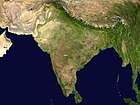The geography of India is extremely diverse, with landscape ranging from snow-capped mountain ranges to deserts, plains, hills and plateaus. Climate ranges from equatorial in the far south, to tundra in the Himalayan altitudes. India comprises most of the Indian subcontinent and has a long coastline of over 7,000 km (4,300 miles), most of which lies on a peninsula that protrudes into the Indian Ocean. India is bounded in the west by the Arabian Sea and in the east by the Bay of Bengal. The fertile Indo-Gangetic plain occupies most of northern, central and eastern India, while the Deccan Plateau occupies most of southern India. To the west of the country is the Thar Desert, which consists of a mix of rocky and sandy desert. India's east and northeastern border consists of the high Himalayan range. The highest point in India is disputed due to a territorial dispute with Pakistan; according to India's claim, the highest point (located in the disputed Kashmir territory) is K2, at 8,611 m (28,251 feet). The highest point in undisputed Indian territory is Kanchenjunga, at 8,598 m (28,208 feet). ( more...)
